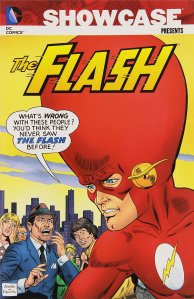Contents: The Flash #162 (June 1966) to #184 (December 1968)
Key Creator Credits: John Broome, Carmine Infantino, Gardner Fox, Ross Andru, Frank Robbins, Cary Bates, and others
Key First Appearances: Julie Schwartz
Story Continues From: Showcase Presents The Flash Vol. 3
Overview: DC Comics published 124 Showcase Presents volumes over the last 10+ years. These volumes covered much of the Silver Age and Bronze Age covering all aspects of the DC Universe. If I had to narrow down my reading adventures to just one volume that best represents the potential of DC Comics, it would be this volume, which has a little bit of everything in the collection. This is Showcase Presents The Flash Vol. 4.
On the surface, this is a fast-paced (pun intended) superhero comic book. You have a true hero, in and out of the red tights, who fights a never-ending battle against a colorful assortment of costumed villains. But The Flash goes beyond the superhero concept. This is a great science fiction title, as the title hero can travel between dimensions. As always, the stories are filled with science facts, making it a learning tool for the reader. Finally, this may be a stretch, but the romance between Barry and Iris is true and would match up to the stories found in Young Love.
This volume contains so many memorable moments that helped shape the DC Universe. We get the wedding of Barry and Iris, which is nearly interrupted by Professor Zoom. We get one of the earliest races between the Flash and Superman, trying to determine who the fastest man alive is. Another Earth is visited, and we finally see a face to go with a familiar name from the credits page. As always, there are some Kid Flash short stories, we get a crossover appearance by Green Lantern, and so much more.
Why should these stories be Showcased?: I really like how this title was always moving forward when other titles were happy maintaining the status quo. This volume sees Barry and Iris finally tie the not, and Barry reveals his secret identity to his wife. Over in the Superman books, a Superman-Lois marriage would only be considered as an imaginary story. I do like these stories, even following the shake-up in the mid-1960s when Broome, Fox and Infantino left the title. Newcomer Cary Bates would have a long run with the Flash’s friends and foes.
Welcome to Earth-Prime!: The Flash comic helped re-introduce the Justice Society characters as still alive and well, but living in an alternate world designated as Earth-2. In issue #179, we are introduced to a new world that would become known as Earth-Prime. On this world, there are no superheroes. In fact, superheroes are only found in the comic books. The Flash travels to New York City to meet DC Comics Editor Julie Schwartz, who is the one person on this Earth most likely to believe the Flash’s story and help him return to Earth-1.
Footnotes: The Flash #169 and #178 are reprint issues. The covers are included in this collection.
If you like this volume, try: the Superman vs. The Flash trade paperback collection from 2005. DC fans for years had debated over which hero is the fastest man alive, Superman or the Flash. Beginning in 1967, we saw a pair of races in each of the characters’ main titles (Superman #199 and The Flash #175). Neither race was conclusive, so it led to future races across multiple books. This trade collects many of those race stories from the Silver and Bronze Ages. The book sports a spectacular Alex Ross cover. So want to know who is faster? Read this trade and find out for yourself.










